In Lincoln’s current all-SUV family, the mid-sized Nautilus occupies what might be thought of as the middle-child position: a vague middle ground where it’s overshadowed by its higher-wattage siblings. The Navigator is the style-setting headline act, the Aviator is its much-ballyhooed follow-up, and the fresh-faced baby Corsair fits in with the luxury realm’s most popular segment. The Nautilus, meanwhile, has been hanging out since 2019, when it debuted not as a new model but as a rework of the former MKX. That means it dates back to 2016. This year, Lincoln gives some more attention to its mid-size, two-row entry, but in classic middle-child fashion, that attention doesn’t extend beyond what was truly necessary.
To that end, the 2021 update focuses almost wholly on the interior. (Outside, there are new paint colors and a redesigned front bumper. Mechanicals are unchanged.) A redesigned dash adopts the horizontal architectural theme used elsewhere in the lineup, although this interior still trails far behind the Navigator and the Aviator for wow factor. Nor are the design and materials equal to the latest from Mercedes-Benz or Volvo. At least Lincoln continues to be more adventurous than the norm with colors, though that’s primarily on the top-spec Black Label with its two themed interiors: Chalet and Flight. Buyers who shy away from vibrant hues and prefer the cold embrace of a Germanic grayscale palette are not ignored, however, as evidenced by my Asher Gray-on-Ebony Nautilus Reserve test vehicle.
In this digital world, no self-respecting luxury car can be without a big screen, and for 2021 the Nautilus gets one. The centerpiece of the redesigned dashboard is a new horizontally oriented touchscreen that measures 13.2 inches, which is half-again as large as the mere 8-incher it replaces. It’s the biggest in the Lincoln lineup and is standard on all trims.
The system runs SYNC 4 and has the ability to accept over-the-air updates. The bright, crisp screen can display two functions at once, such as showing the map in the larger field and music info in the smaller one. Impressively, it can simultaneously display info from two different sources. For instance, the audio can be from car’s satellite radio while the map is the Waze app on a paired smartphone. Smartphone mirroring, by the way, is wireless, and wireless charging is included on the two upper trims.
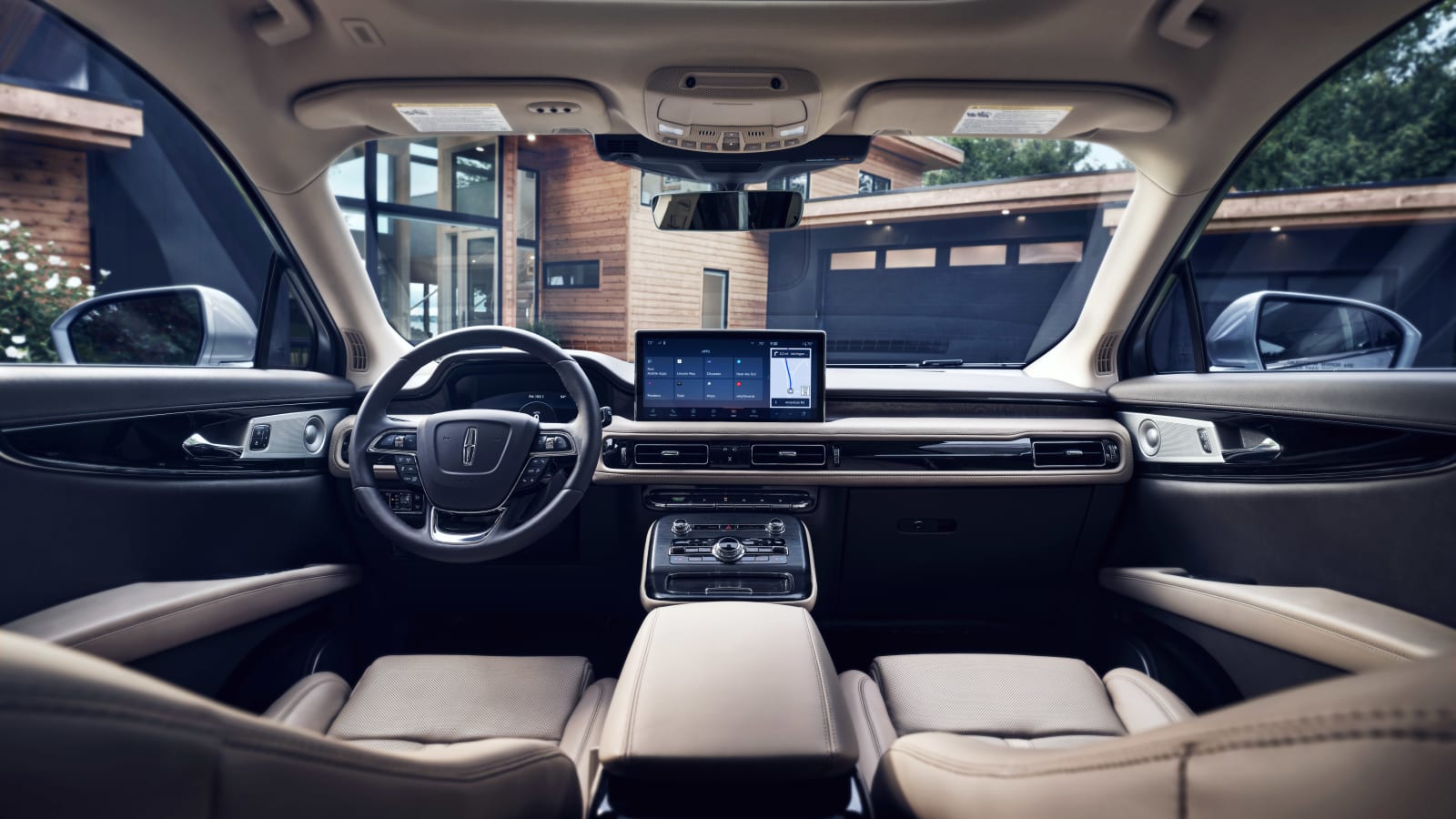

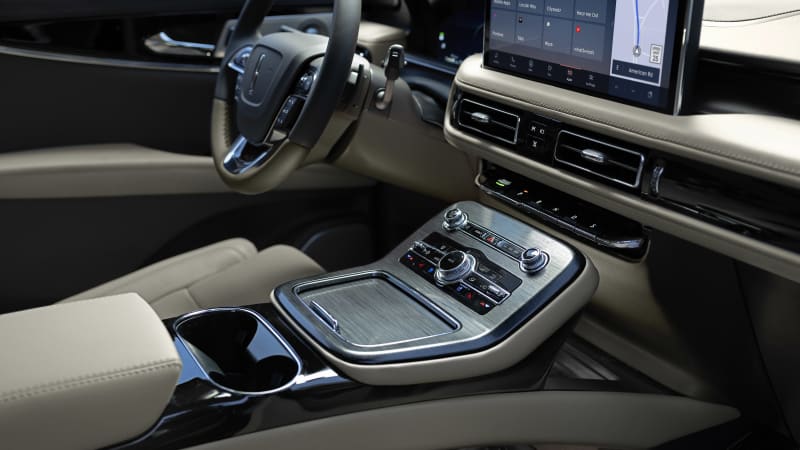
A row of shortcut keys at the bottom of the screen allows you to jump to major functions, and there’s a padded ledge at its base that provides a perch on which to rest your hand. Thankfully, Lincoln has not banished physical controls in a quest for modernity. A pair of knurled knobs control volume and tuning, with buttons in between for audio source, seek up/down, and screen on/off. A bank of buttons below that operates the climate control system, with a big knob for fan speed. Touch the middle of that knob to call up further climate controls on the screen.
Somewhat surprisingly, Lincoln did not take this opportunity to make the “Perfect Position” seats found in all its other models available in the Nautilus. While those seats have an impressive range of adjustability including separate under-thigh support for the left and right legs, they’re also thinly and firmly padded. Every body is different, but I found the optional 22-way driver’s seat in this Nautilus to be more comfortable. Its range of adjustments includes three lumbar sections, extendable under-thigh support, and an articulating backrest. There are also multiple massage programs. The upgraded seats come with heating and cooling; standard is a 10-way power driver’s seat with heating only.
Moving to the rear seat, one finds plenty of knee- and legroom, but the panoramic sunroof reduces headroom slightly, which may be an issue for passengers much over six feet. A nearly flat floor makes the bench viable for three-across seating. A mixed pair of USB ports is on hand, and heated rear seats are available.
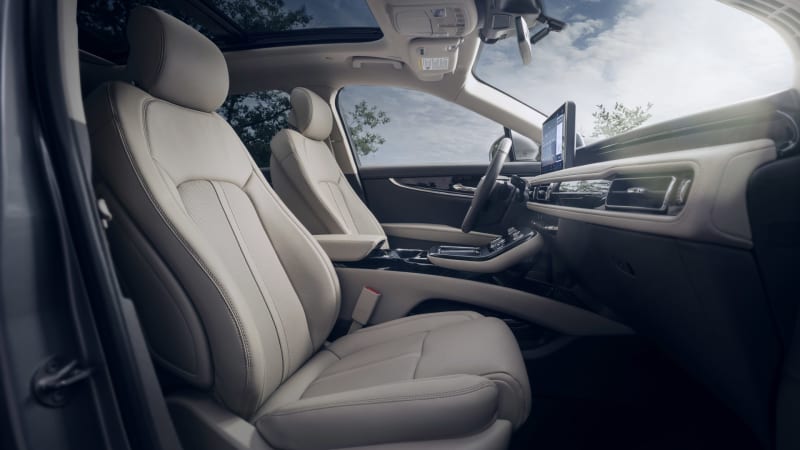
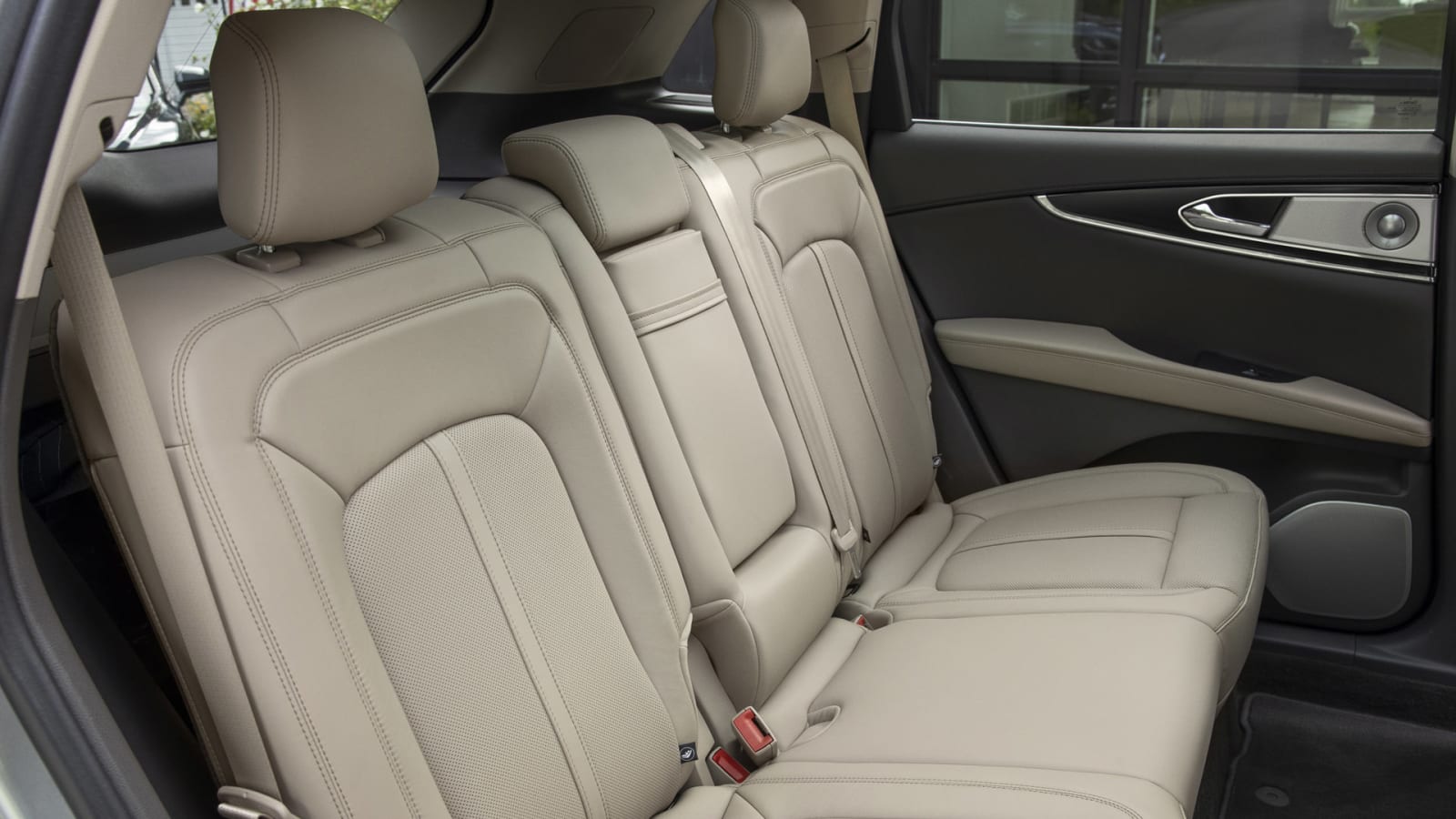
Behind the rear seats, there’s 37.2 cubic feet of luggage space in the ample cargo hold, and 68.8 cubic feet with the seatbacks folded. Those figures put the Lincoln’s luggage space toward the larger end of the spectrum, topping the Lexus RX and the arch-rival Cadillac XT5. In-cabin stowage is quite good. The center console has multiple cubbies, one on the top level with USB-C and USB-A ports inside, a large open one underneath, another at mid-level, plus the usual covered bin under the center armrest.
Switching to the business end of the Nautilus, there are no changes in the engine room, where buyers choose either a 2.0-liter turbo four-cylinder or a 2.7-liter twin-turbo V6. The 2.0-liter serves up 250 horsepower and 280 pound-feet of torque and can be had with front-wheel drive or all-wheel drive. The 2.7-liter V6 spins out 335 hp and 380 lb-ft and is AWD only. Both engines are paired with an eight-speed automatic transmission, now operated by Lincoln’s row of horizontal “piano key” buttons.
My test example had the 2.7, and its 380 lb-ft of torque puts some spring in this Lincoln’s step. There’s plenty of grunt on tap to go charging out into busy, fast-moving traffic or to execute a quick two-lane pass. If you get on it with the wheel turned, you can get a squirm of torque steer before the engine’s torque is redirected to the rear. Although plenty potent, this engine isn’t overtly sporty — that’s not what Lincoln is going for here. It’s largely silent with a muted growl only under heavy throttle. In town, the accelerator is a little touchy, but the auto stop-start system is unobtrusive.
EPA estimates for the V6 engine are at most just 1 mpg below those of the four-cylinder, with the V6 at 19 mpg city, 25 mpg highway and 21 mpg combined and the AWD 2.0-liter at 20/25/22 mpg. The front-drive 2.0-liter comes in at 23/21/26 mpg. Those estimates make the four-cylinder thriftier than various competitors, including the Volvo XC60 and four-cylinder Cadillac XT5. The V6 basically matches the RX 350 and V6-powered XT5 despite being far more powerful. It also did better than expected in the real world: over 150 miles, I averaged 24 mpg in mostly suburban driving.
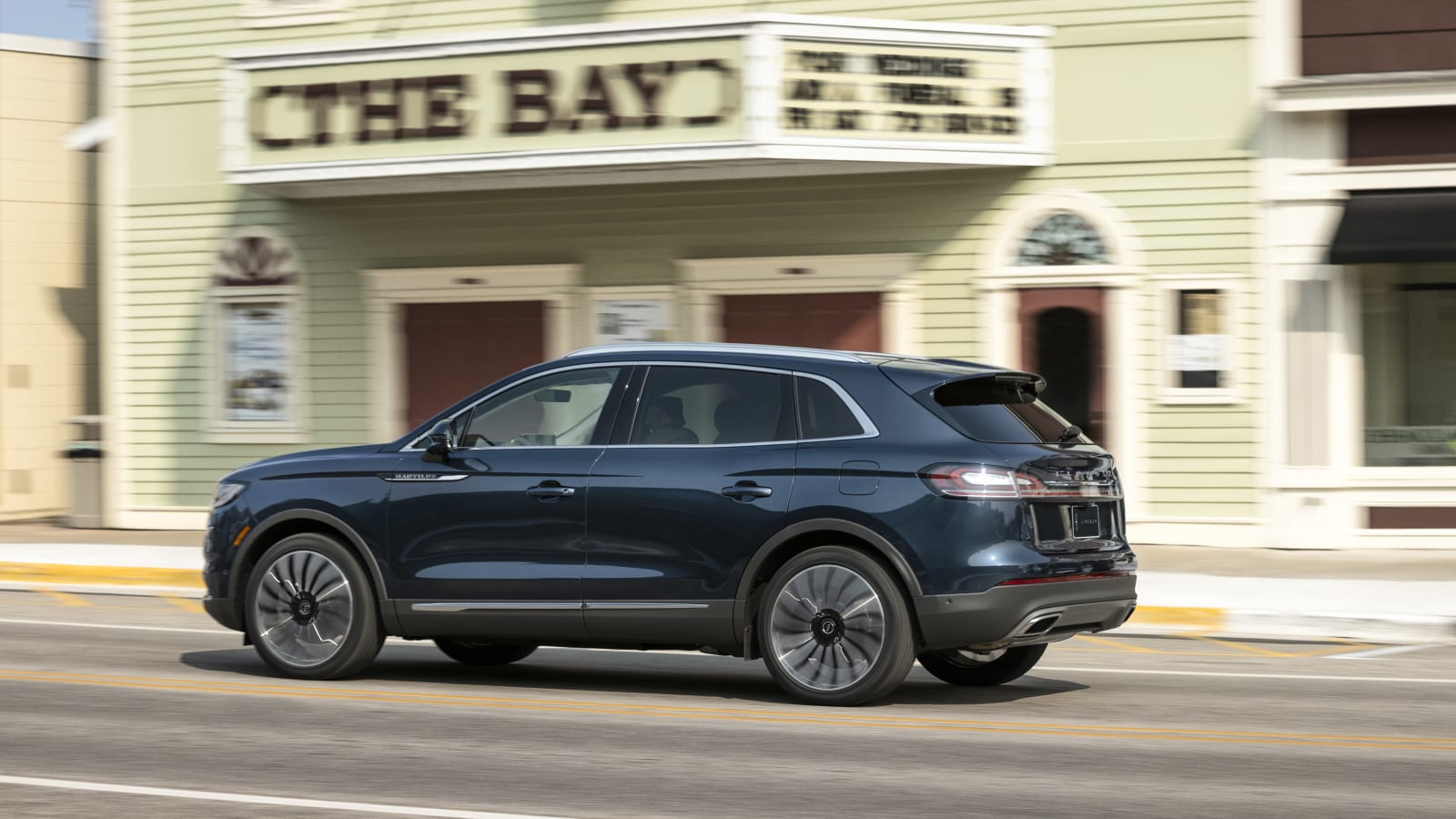
Winter-thaw potholes have blossomed here in New York, which gave the Nautilus suspension a workout. While the dampers and bushings successfully round off the impacts, disturbances do still get through to the cabin, and at times there is also some side-to-side rocking motion. My test car was equipped with adaptive damping with three modes: Comfort, Normal, and Sport. The differences between them are not that pronounced, and surprisingly the Sport mode’s superior body control really didn’t come at a cost of any additional harshness. At the same time, Sport doesn’t work a whole lot of magic when the road turns twisty. Powering through some winding rural roads, the Lincoln in any mode proves to be more of a relaxed cruiser than an energetic charger. The steering, though, is pleasantly if artificially weighted.
The Nautilus comes with a competitive suite of standard active-safety features (Lincoln Co-Pilot360) that includes forward-collision warning, lane-departure warning, lane-keeping assist, blind-spot monitoring and rear cross-traffic alert. The available Co-Pilot360 Plus adds Enhanced Active Park Assist, Evasive Steering Assist, a 360-degree-view camera with a front sensing system, and adaptive cruise control with stop-and-go capability as well as lane-centering.
The lane-centering feature, which requires a hand on the wheel, works well provided the highway is clearly marked. The multi-view camera includes not just a top-down view but also a forward-facing cam for peeking out into traffic or nosing in close when parking. The camera is easy to summon with a dedicated button, but the image is disappointingly grainy.
Helping the Nautilus’s perceived modernity is Lincoln’s Phone As A Key feature, which as its name implies allows owners to leave their key fob at home and use a paired smartphone to unlock and start their car. This feature is optional on the Reserve and standard on the Black Label.
The Nautilus opens at $42,935 (including destination) for the Standard model. The mid-range Reserve starts at $50,405. The top Black Label trim is $66,085. Besides its additional equipment, the Black Label also brings owner perks such as free maintenance for four years/50,000 miles, pick-up and delivery for service, and free carwashes. My fully loaded Reserve rang in at $66,890, and the major culprits running up the tab were the V6 engine and AWD for $5,195 (adding AWD to the 2.0-liter costs $2,500); a $3,420 bundle that brought Co-Pilot360 Plus, 20-inch wheels, and Phone As A Key; a $1,695 Monochromatic package of black exterior design elements; and the Ultra Comfort 22-way front seats for $1,500. The Reserve probably makes the most sense in this lineup, although dialing back the add-ons here would make a better case for the Nautilus. Even the swell turbo V6 hardly seems essential in a relaxed cruiser like this.
“Nautilus” was the name given to the U.S. Navy’s first nuclear-powered submarine, and while this comfy and quiet Lincoln isn’t as stealthy as that undersea vessel, it doesn’t exactly demand attention. The changes to the 2021 Nautilus are welcome — perhaps even essential, given the centrality of screen interactions in our driving lives. Still, this model’s persona, and its position vis-a-vis Lincoln’s family dynamic, remain intact.
Related Video:

